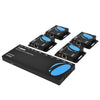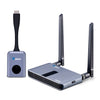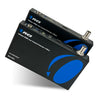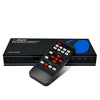Difference between HDMI Splitter, HDMI Switch, and HDMI Matrix
HDMI Splitter vs HDMI Switch vs HDMI Matrix
To help you better understand the differences between an HDMI Splitter, an HDMI Switch, and an HDMI Matrix, we’ll be doing a quick and easy run-through on their basic definitions.
For easier understanding, let’s first define some of the terms that will be used in this article.
HDMI inputs refer to the source of your HDMI media content. This content source could be a gaming console, a DVD player, or a computer.
HDMI outputs refer to the device where you’ll be displaying your HDMI content. Your HDMI output could be your monitor or your TV.
HDMI devices refer to equipment or gears such as HDMI Splitter, HDMI Switch, or HDMI Matrix.
Now that we settled that, let’s continue to the main part of this discussion.
What is an HDMI Splitter?
An HDMI Splitter takes a single input of HDMI media content and splits that into multiple outputs. For instance, if you’ll be using an HDMI Splitter for TVs, such as the OREI BK102 1x2 (which is an HDMI Splitter 1 in, 2 out), then you’ll be able to simultaneously display the same image on 2 different TVs.
HDMI Splitters are usually available in the market with 4 outputs, 8 outputs, or even more, but the most commonly used for home setups are those with 2 outputs.
What is an HDMI Switch?
An HDMI Switch allows you to provide a single monitor with multiple HDMI inputs. HDMI Switches are perfect if you have multiple multimedia devices on your desk, or have a media center where you have your gaming console, DVD player, and computer.
For example, if you have the OREI BK-21A 2x1 HDMI Switch box, then you can connect two of your multimedia devices to one TV and be able to choose which one you want to be displayed with just a click of a button.
What is an HDMI Matrix?
An HDMI Matrix, or an HDMI Matrix Switch, is the most complicated, yet most flexible among the three. An HDMI Matrix essentially combines the functions of both your HDMI Splitter and HDMI Switch.
For instance, if you have a 2x2 HDMI Matrix such as the OREI BK 202A 2x2, that means that you can connect 2 different input devices to 2 different display outputs. With a matrix switch, you have full control of which input you want to send to which output. Further, you can also opt to choose one input and display it to 2 outputs.
How to set up your HDMI Splitter, Switch, or Matrix
- Connect your input and output devices in their respective ports.
- Turn on your input and output devices, and connect your HDMI device to a power source as well.
- If everything is connected properly, your output should prompt a display within a few seconds.
What happens when you turn on your OREI HDMI device?
Upon adding power, it immediately starts a self-test to properly check if all its electronics are functioning fine. After a couple of seconds, it then starts checking the resolutions of your input and output devices and makes the right adjustments needed in order for you to see the best possible image on your display.
Why you should consider purchasing your HDMI Splitter, Switch, or Matrix from OREI
The first reason is that OREI builds products with your future in mind. OREI equips its products with advanced features so that all their devices are still usable even if you choose to upgrade your setup later on.
OREI builds products with the future in mind. By equipping their products with advanced features, you’re sure that the HDMI device you’ll be buying is still usable even if you choose to upgrade your setup later on. Here are a few more reasons.
-
Resolution
Even though you’re enjoying 4K resolution today, you will eventually upgrade your gears to those that can support 8K. The 3 mentioned products in this article, which are the OREI BK102A, BK-21A, and BK202A are all equipped with the capability of supporting 8K Ultra HD media content so that even if you upgrade in the future, you can expect that these HDMI devices can still support it.
-
Certification Level
All the products mentioned in this article are all fully HDMI 2.1 and HDCP 2.3 compliant. But why is this important?
They are important because HDMI standards have improved a lot over the last few years, and they now include more features that you’ll want to make use of. These are things such as CEC (Consumer Electronics Control) that allow you to take control of all your media equipment with a single remote. Other features also include the highly sought-after ARC, eARC, and HDR. All of these are built into the HDMI 2.1 Standard.
On the other hand, the HDCP Compliant-factor of HDMI devices controls the copy-protected content that they can support. For example, if you decide to play HDCP copy-protected content that requires a 2.3 certification and you’re using one that can only support an older version, then that device will not be able to display it.
For you to be able to watch the widest variety of media content without worrying about complying with HDCP 2.3 and HDMI 2.1, switch to the devices that can support them such as the three products mentioned in this article.
-
Inclusion of remote controls in the Switch and the Matrix
While having a remote seems like a superficial feature, it actually allows you to have more flexibility in terms of your setup. Imagine enjoying your media room while resting comfortably on your couch but then you have to stand up because you have to click a button on your HDMI device.
With a remote control, you’re free to place your HDMI device anywhere in your media room. You can have it placed on a top shelf, or inside a glass cabinet. Either way, you can easily control it by using your remote.





























